International Business Analysis: Tesla's Global Market Strategy Report
VerifiedAdded on 2022/09/14
|17
|4278
|8
Report
AI Summary
This report provides a comprehensive analysis of Tesla's international business strategy, examining the motives behind its global expansion, with a particular focus on market development, economies of scale, and risk mitigation using models like the Uppsala model and economic theories of comparative advantage. The report identifies India as a prime target market, justifying this choice through PESTLE and Porter Diamond analyses, considering political, economic, social, technological, legal, and environmental factors, as well as competitive advantages. The report also discusses Tesla's product lifecycle considerations and recommends strategies for market entry and expansion, emphasizing the potential for extending product lifecycles and maximizing business revenue in the Indian market. The report aims to provide recommendations on the most effective entry strategies, including the selection of India as the target market and the application of various analytical models to support these decisions. The analysis considers the Indian market's economic growth, large population, technological advancements, and environmental factors, highlighting both opportunities and challenges for Tesla.
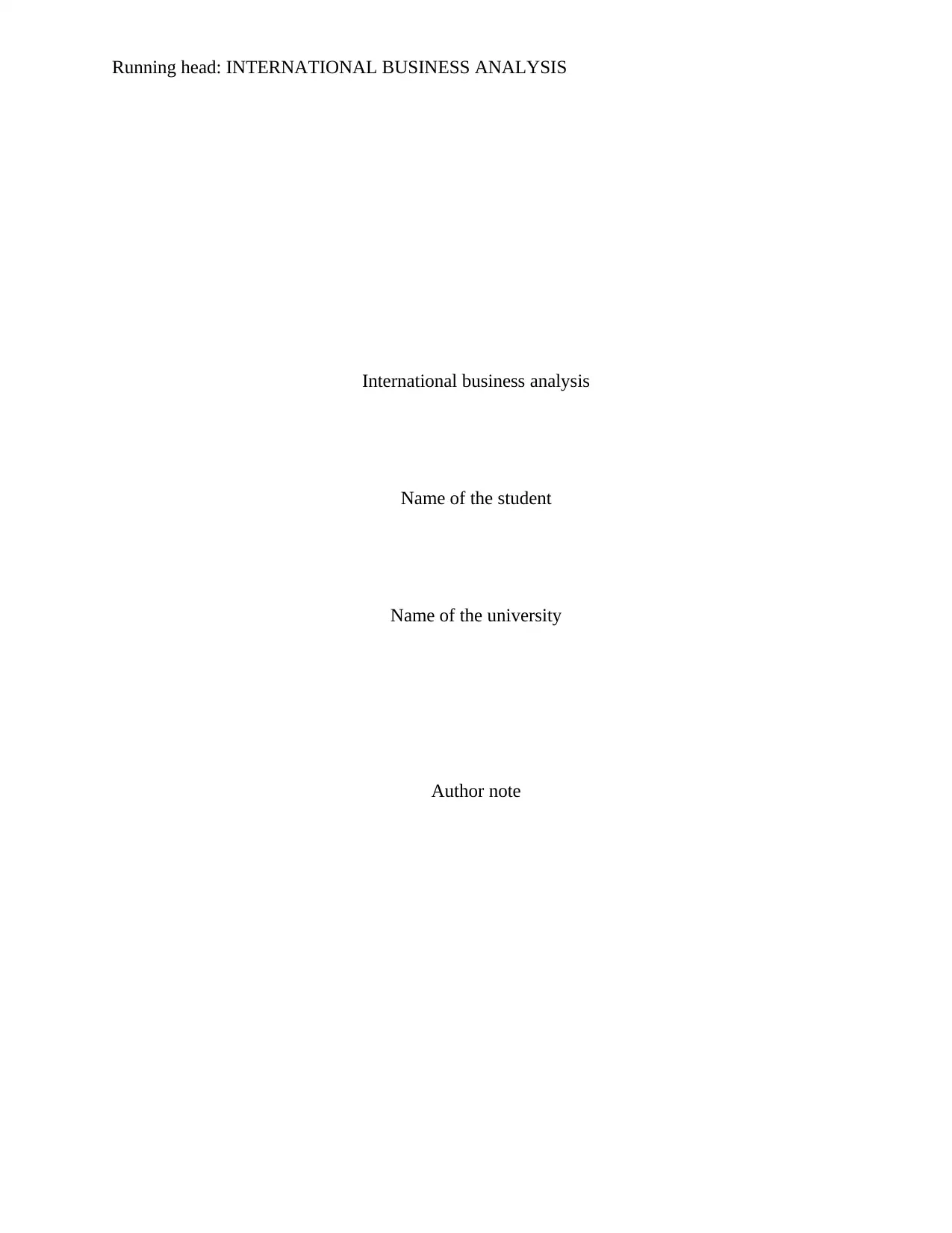
Running head: INTERNATIONAL BUSINESS ANALYSIS
International business analysis
Name of the student
Name of the university
Author note
International business analysis
Name of the student
Name of the university
Author note
Paraphrase This Document
Need a fresh take? Get an instant paraphrase of this document with our AI Paraphraser
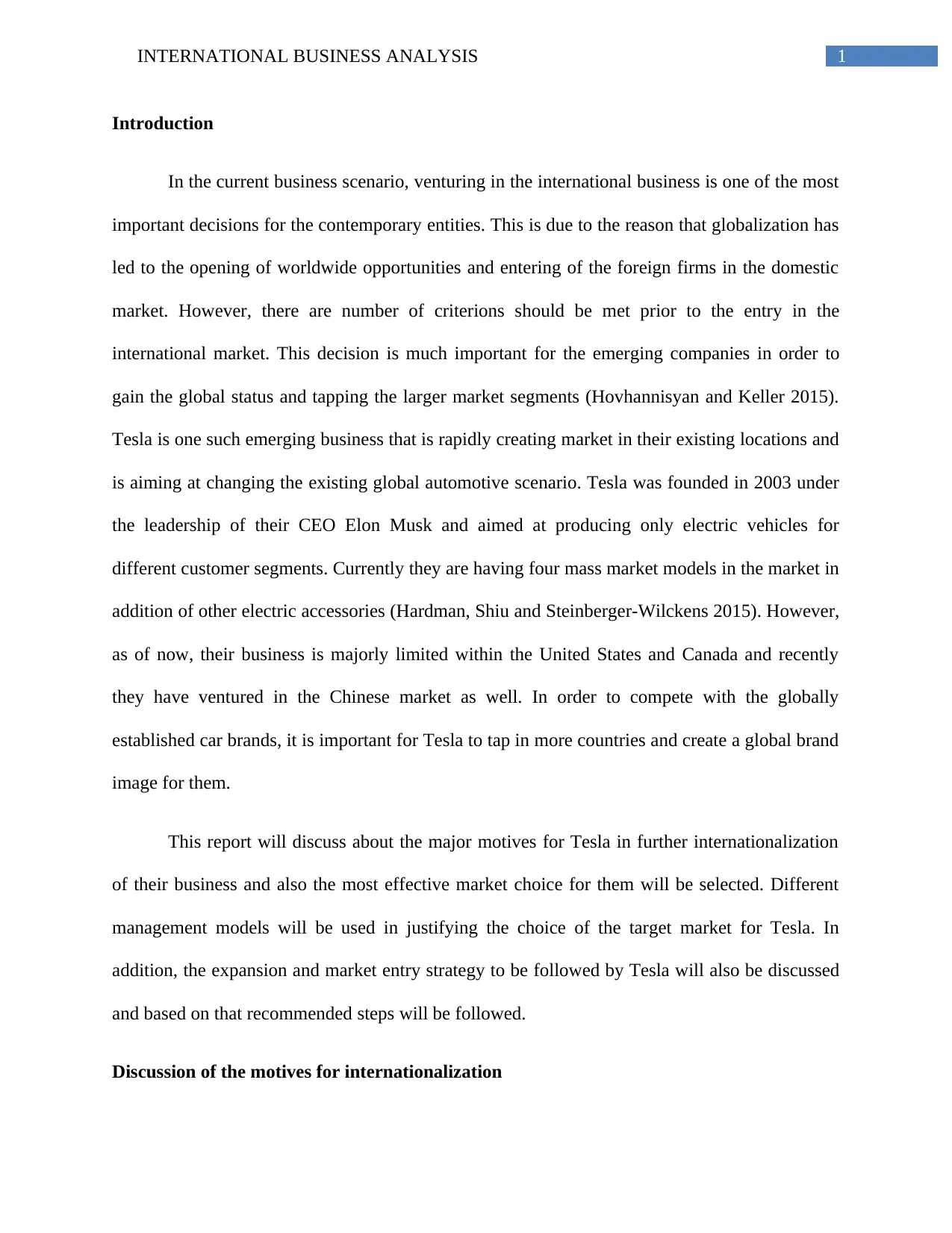
1INTERNATIONAL BUSINESS ANALYSIS
Introduction
In the current business scenario, venturing in the international business is one of the most
important decisions for the contemporary entities. This is due to the reason that globalization has
led to the opening of worldwide opportunities and entering of the foreign firms in the domestic
market. However, there are number of criterions should be met prior to the entry in the
international market. This decision is much important for the emerging companies in order to
gain the global status and tapping the larger market segments (Hovhannisyan and Keller 2015).
Tesla is one such emerging business that is rapidly creating market in their existing locations and
is aiming at changing the existing global automotive scenario. Tesla was founded in 2003 under
the leadership of their CEO Elon Musk and aimed at producing only electric vehicles for
different customer segments. Currently they are having four mass market models in the market in
addition of other electric accessories (Hardman, Shiu and Steinberger-Wilckens 2015). However,
as of now, their business is majorly limited within the United States and Canada and recently
they have ventured in the Chinese market as well. In order to compete with the globally
established car brands, it is important for Tesla to tap in more countries and create a global brand
image for them.
This report will discuss about the major motives for Tesla in further internationalization
of their business and also the most effective market choice for them will be selected. Different
management models will be used in justifying the choice of the target market for Tesla. In
addition, the expansion and market entry strategy to be followed by Tesla will also be discussed
and based on that recommended steps will be followed.
Discussion of the motives for internationalization
Introduction
In the current business scenario, venturing in the international business is one of the most
important decisions for the contemporary entities. This is due to the reason that globalization has
led to the opening of worldwide opportunities and entering of the foreign firms in the domestic
market. However, there are number of criterions should be met prior to the entry in the
international market. This decision is much important for the emerging companies in order to
gain the global status and tapping the larger market segments (Hovhannisyan and Keller 2015).
Tesla is one such emerging business that is rapidly creating market in their existing locations and
is aiming at changing the existing global automotive scenario. Tesla was founded in 2003 under
the leadership of their CEO Elon Musk and aimed at producing only electric vehicles for
different customer segments. Currently they are having four mass market models in the market in
addition of other electric accessories (Hardman, Shiu and Steinberger-Wilckens 2015). However,
as of now, their business is majorly limited within the United States and Canada and recently
they have ventured in the Chinese market as well. In order to compete with the globally
established car brands, it is important for Tesla to tap in more countries and create a global brand
image for them.
This report will discuss about the major motives for Tesla in further internationalization
of their business and also the most effective market choice for them will be selected. Different
management models will be used in justifying the choice of the target market for Tesla. In
addition, the expansion and market entry strategy to be followed by Tesla will also be discussed
and based on that recommended steps will be followed.
Discussion of the motives for internationalization
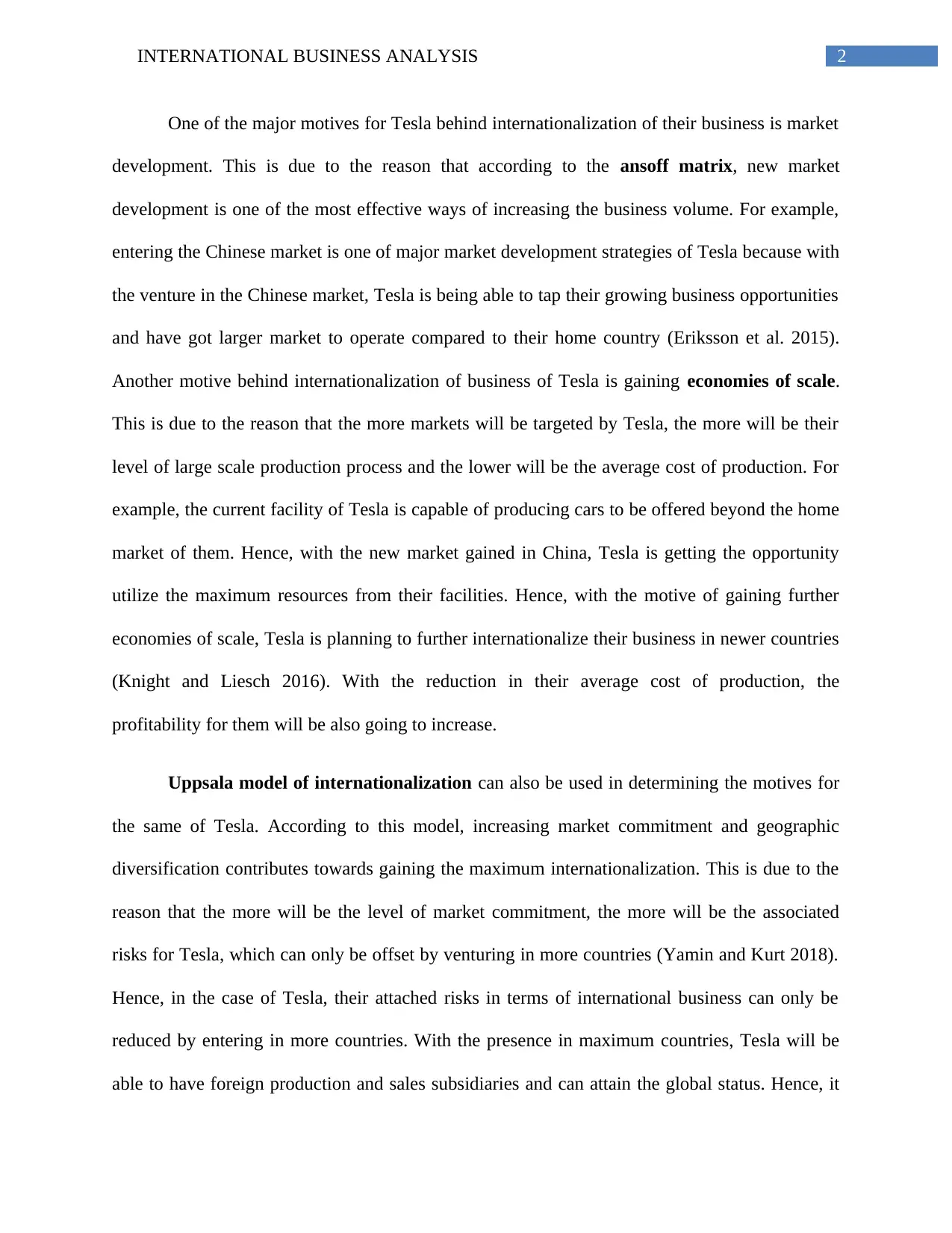
2INTERNATIONAL BUSINESS ANALYSIS
One of the major motives for Tesla behind internationalization of their business is market
development. This is due to the reason that according to the ansoff matrix, new market
development is one of the most effective ways of increasing the business volume. For example,
entering the Chinese market is one of major market development strategies of Tesla because with
the venture in the Chinese market, Tesla is being able to tap their growing business opportunities
and have got larger market to operate compared to their home country (Eriksson et al. 2015).
Another motive behind internationalization of business of Tesla is gaining economies of scale.
This is due to the reason that the more markets will be targeted by Tesla, the more will be their
level of large scale production process and the lower will be the average cost of production. For
example, the current facility of Tesla is capable of producing cars to be offered beyond the home
market of them. Hence, with the new market gained in China, Tesla is getting the opportunity
utilize the maximum resources from their facilities. Hence, with the motive of gaining further
economies of scale, Tesla is planning to further internationalize their business in newer countries
(Knight and Liesch 2016). With the reduction in their average cost of production, the
profitability for them will be also going to increase.
Uppsala model of internationalization can also be used in determining the motives for
the same of Tesla. According to this model, increasing market commitment and geographic
diversification contributes towards gaining the maximum internationalization. This is due to the
reason that the more will be the level of market commitment, the more will be the associated
risks for Tesla, which can only be offset by venturing in more countries (Yamin and Kurt 2018).
Hence, in the case of Tesla, their attached risks in terms of international business can only be
reduced by entering in more countries. With the presence in maximum countries, Tesla will be
able to have foreign production and sales subsidiaries and can attain the global status. Hence, it
One of the major motives for Tesla behind internationalization of their business is market
development. This is due to the reason that according to the ansoff matrix, new market
development is one of the most effective ways of increasing the business volume. For example,
entering the Chinese market is one of major market development strategies of Tesla because with
the venture in the Chinese market, Tesla is being able to tap their growing business opportunities
and have got larger market to operate compared to their home country (Eriksson et al. 2015).
Another motive behind internationalization of business of Tesla is gaining economies of scale.
This is due to the reason that the more markets will be targeted by Tesla, the more will be their
level of large scale production process and the lower will be the average cost of production. For
example, the current facility of Tesla is capable of producing cars to be offered beyond the home
market of them. Hence, with the new market gained in China, Tesla is getting the opportunity
utilize the maximum resources from their facilities. Hence, with the motive of gaining further
economies of scale, Tesla is planning to further internationalize their business in newer countries
(Knight and Liesch 2016). With the reduction in their average cost of production, the
profitability for them will be also going to increase.
Uppsala model of internationalization can also be used in determining the motives for
the same of Tesla. According to this model, increasing market commitment and geographic
diversification contributes towards gaining the maximum internationalization. This is due to the
reason that the more will be the level of market commitment, the more will be the associated
risks for Tesla, which can only be offset by venturing in more countries (Yamin and Kurt 2018).
Hence, in the case of Tesla, their attached risks in terms of international business can only be
reduced by entering in more countries. With the presence in maximum countries, Tesla will be
able to have foreign production and sales subsidiaries and can attain the global status. Hence, it
⊘ This is a preview!⊘
Do you want full access?
Subscribe today to unlock all pages.

Trusted by 1+ million students worldwide
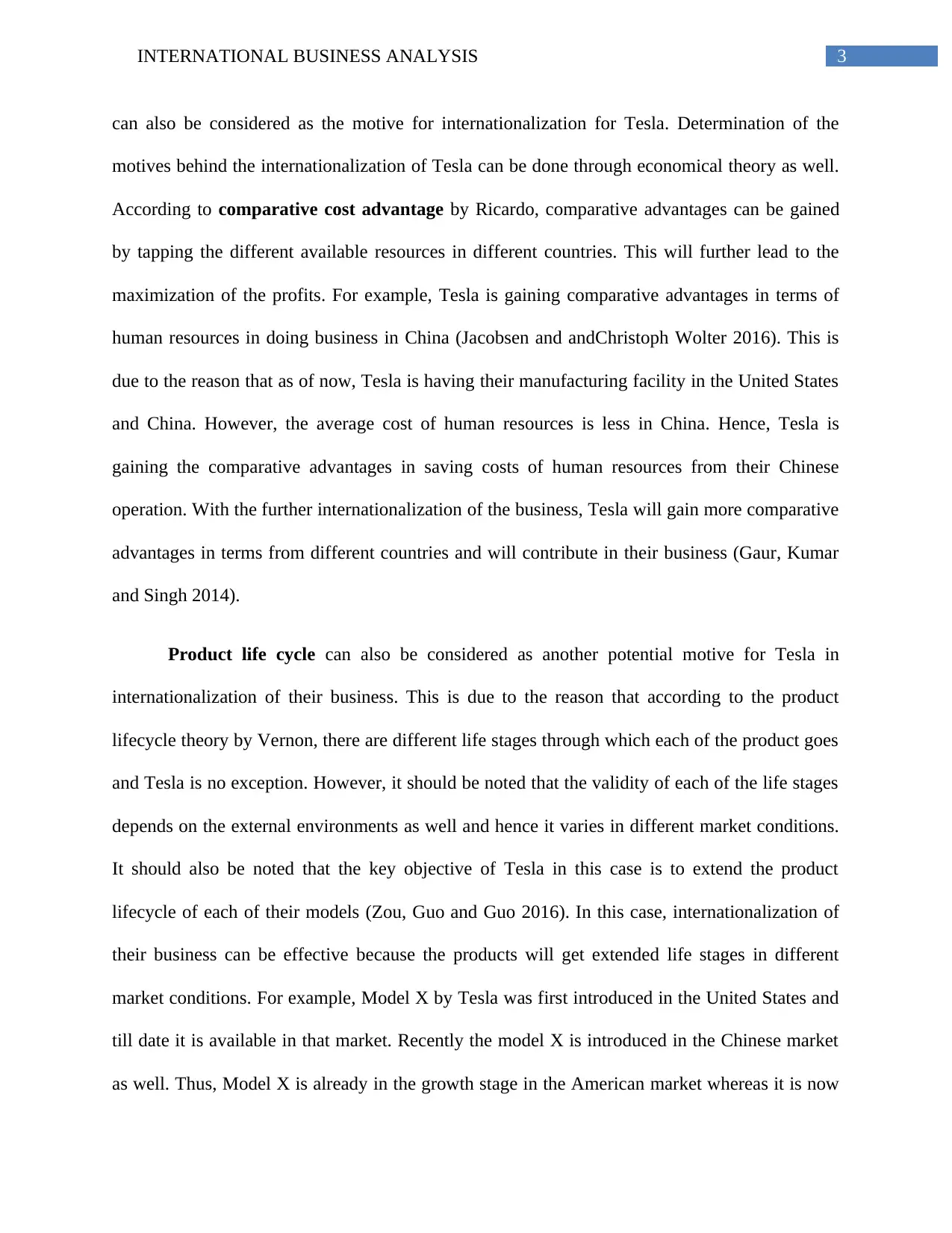
3INTERNATIONAL BUSINESS ANALYSIS
can also be considered as the motive for internationalization for Tesla. Determination of the
motives behind the internationalization of Tesla can be done through economical theory as well.
According to comparative cost advantage by Ricardo, comparative advantages can be gained
by tapping the different available resources in different countries. This will further lead to the
maximization of the profits. For example, Tesla is gaining comparative advantages in terms of
human resources in doing business in China (Jacobsen and andChristoph Wolter 2016). This is
due to the reason that as of now, Tesla is having their manufacturing facility in the United States
and China. However, the average cost of human resources is less in China. Hence, Tesla is
gaining the comparative advantages in saving costs of human resources from their Chinese
operation. With the further internationalization of the business, Tesla will gain more comparative
advantages in terms from different countries and will contribute in their business (Gaur, Kumar
and Singh 2014).
Product life cycle can also be considered as another potential motive for Tesla in
internationalization of their business. This is due to the reason that according to the product
lifecycle theory by Vernon, there are different life stages through which each of the product goes
and Tesla is no exception. However, it should be noted that the validity of each of the life stages
depends on the external environments as well and hence it varies in different market conditions.
It should also be noted that the key objective of Tesla in this case is to extend the product
lifecycle of each of their models (Zou, Guo and Guo 2016). In this case, internationalization of
their business can be effective because the products will get extended life stages in different
market conditions. For example, Model X by Tesla was first introduced in the United States and
till date it is available in that market. Recently the model X is introduced in the Chinese market
as well. Thus, Model X is already in the growth stage in the American market whereas it is now
can also be considered as the motive for internationalization for Tesla. Determination of the
motives behind the internationalization of Tesla can be done through economical theory as well.
According to comparative cost advantage by Ricardo, comparative advantages can be gained
by tapping the different available resources in different countries. This will further lead to the
maximization of the profits. For example, Tesla is gaining comparative advantages in terms of
human resources in doing business in China (Jacobsen and andChristoph Wolter 2016). This is
due to the reason that as of now, Tesla is having their manufacturing facility in the United States
and China. However, the average cost of human resources is less in China. Hence, Tesla is
gaining the comparative advantages in saving costs of human resources from their Chinese
operation. With the further internationalization of the business, Tesla will gain more comparative
advantages in terms from different countries and will contribute in their business (Gaur, Kumar
and Singh 2014).
Product life cycle can also be considered as another potential motive for Tesla in
internationalization of their business. This is due to the reason that according to the product
lifecycle theory by Vernon, there are different life stages through which each of the product goes
and Tesla is no exception. However, it should be noted that the validity of each of the life stages
depends on the external environments as well and hence it varies in different market conditions.
It should also be noted that the key objective of Tesla in this case is to extend the product
lifecycle of each of their models (Zou, Guo and Guo 2016). In this case, internationalization of
their business can be effective because the products will get extended life stages in different
market conditions. For example, Model X by Tesla was first introduced in the United States and
till date it is available in that market. Recently the model X is introduced in the Chinese market
as well. Thus, Model X is already in the growth stage in the American market whereas it is now
Paraphrase This Document
Need a fresh take? Get an instant paraphrase of this document with our AI Paraphraser
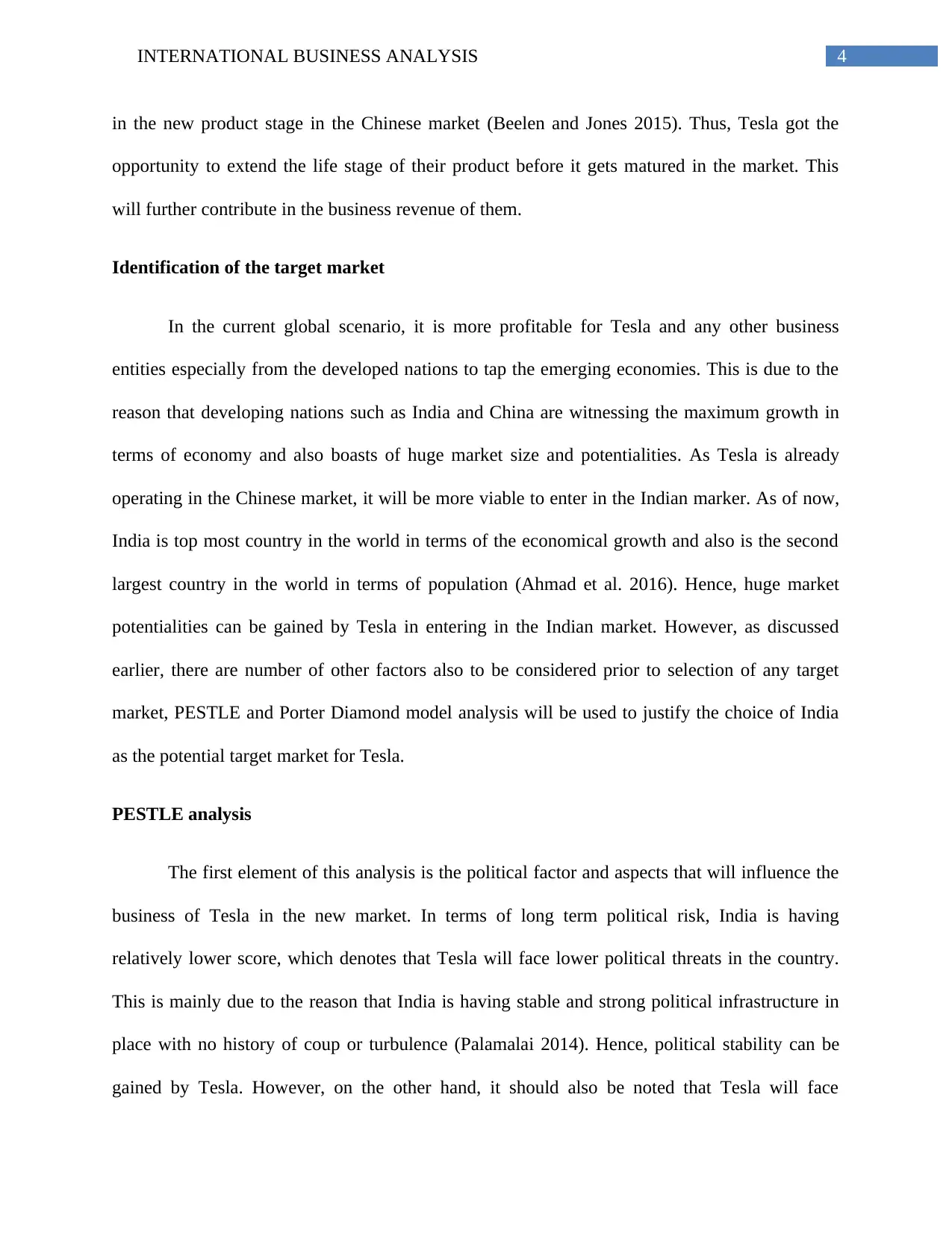
4INTERNATIONAL BUSINESS ANALYSIS
in the new product stage in the Chinese market (Beelen and Jones 2015). Thus, Tesla got the
opportunity to extend the life stage of their product before it gets matured in the market. This
will further contribute in the business revenue of them.
Identification of the target market
In the current global scenario, it is more profitable for Tesla and any other business
entities especially from the developed nations to tap the emerging economies. This is due to the
reason that developing nations such as India and China are witnessing the maximum growth in
terms of economy and also boasts of huge market size and potentialities. As Tesla is already
operating in the Chinese market, it will be more viable to enter in the Indian marker. As of now,
India is top most country in the world in terms of the economical growth and also is the second
largest country in the world in terms of population (Ahmad et al. 2016). Hence, huge market
potentialities can be gained by Tesla in entering in the Indian market. However, as discussed
earlier, there are number of other factors also to be considered prior to selection of any target
market, PESTLE and Porter Diamond model analysis will be used to justify the choice of India
as the potential target market for Tesla.
PESTLE analysis
The first element of this analysis is the political factor and aspects that will influence the
business of Tesla in the new market. In terms of long term political risk, India is having
relatively lower score, which denotes that Tesla will face lower political threats in the country.
This is mainly due to the reason that India is having stable and strong political infrastructure in
place with no history of coup or turbulence (Palamalai 2014). Hence, political stability can be
gained by Tesla. However, on the other hand, it should also be noted that Tesla will face
in the new product stage in the Chinese market (Beelen and Jones 2015). Thus, Tesla got the
opportunity to extend the life stage of their product before it gets matured in the market. This
will further contribute in the business revenue of them.
Identification of the target market
In the current global scenario, it is more profitable for Tesla and any other business
entities especially from the developed nations to tap the emerging economies. This is due to the
reason that developing nations such as India and China are witnessing the maximum growth in
terms of economy and also boasts of huge market size and potentialities. As Tesla is already
operating in the Chinese market, it will be more viable to enter in the Indian marker. As of now,
India is top most country in the world in terms of the economical growth and also is the second
largest country in the world in terms of population (Ahmad et al. 2016). Hence, huge market
potentialities can be gained by Tesla in entering in the Indian market. However, as discussed
earlier, there are number of other factors also to be considered prior to selection of any target
market, PESTLE and Porter Diamond model analysis will be used to justify the choice of India
as the potential target market for Tesla.
PESTLE analysis
The first element of this analysis is the political factor and aspects that will influence the
business of Tesla in the new market. In terms of long term political risk, India is having
relatively lower score, which denotes that Tesla will face lower political threats in the country.
This is mainly due to the reason that India is having stable and strong political infrastructure in
place with no history of coup or turbulence (Palamalai 2014). Hence, political stability can be
gained by Tesla. However, on the other hand, it should also be noted that Tesla will face
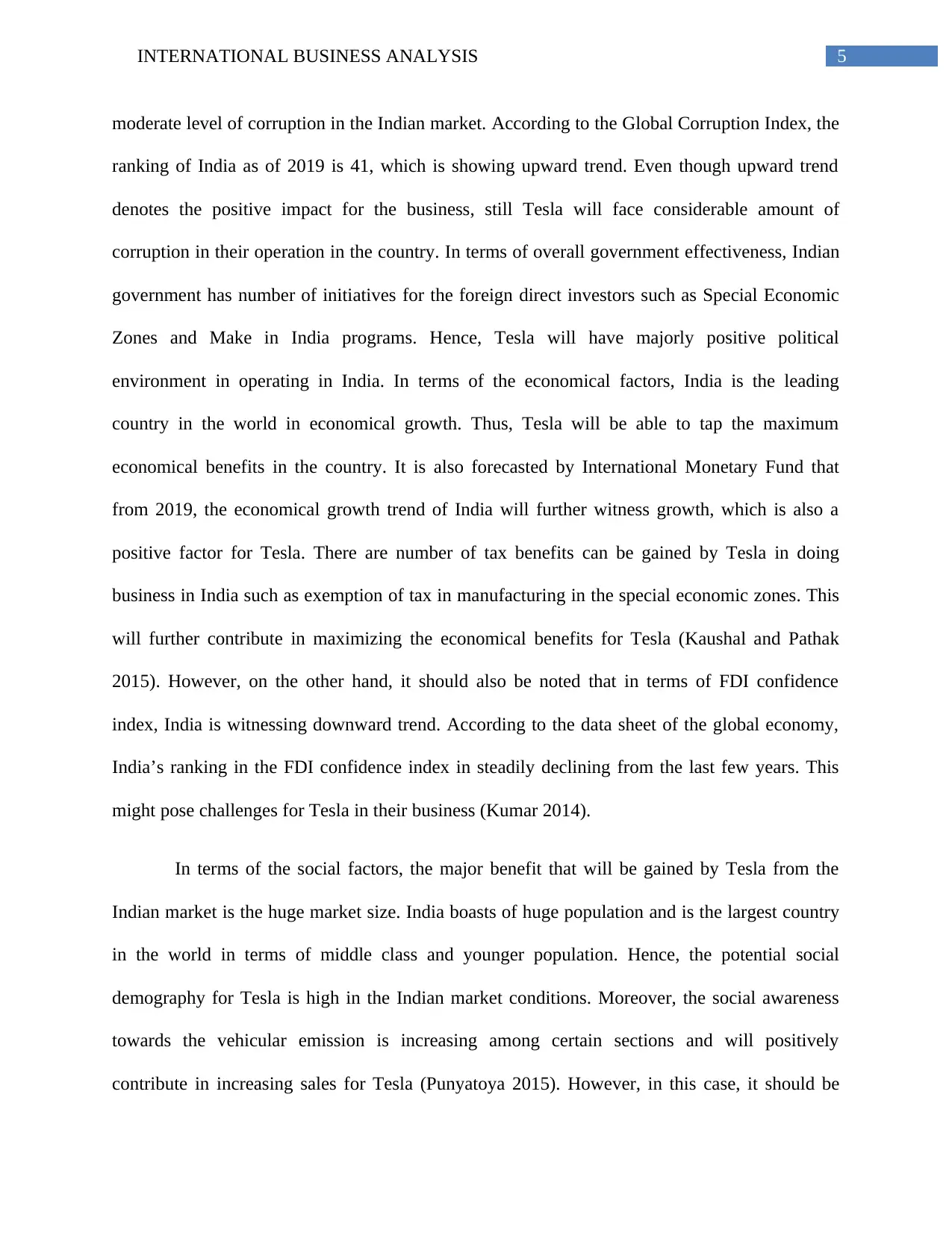
5INTERNATIONAL BUSINESS ANALYSIS
moderate level of corruption in the Indian market. According to the Global Corruption Index, the
ranking of India as of 2019 is 41, which is showing upward trend. Even though upward trend
denotes the positive impact for the business, still Tesla will face considerable amount of
corruption in their operation in the country. In terms of overall government effectiveness, Indian
government has number of initiatives for the foreign direct investors such as Special Economic
Zones and Make in India programs. Hence, Tesla will have majorly positive political
environment in operating in India. In terms of the economical factors, India is the leading
country in the world in economical growth. Thus, Tesla will be able to tap the maximum
economical benefits in the country. It is also forecasted by International Monetary Fund that
from 2019, the economical growth trend of India will further witness growth, which is also a
positive factor for Tesla. There are number of tax benefits can be gained by Tesla in doing
business in India such as exemption of tax in manufacturing in the special economic zones. This
will further contribute in maximizing the economical benefits for Tesla (Kaushal and Pathak
2015). However, on the other hand, it should also be noted that in terms of FDI confidence
index, India is witnessing downward trend. According to the data sheet of the global economy,
India’s ranking in the FDI confidence index in steadily declining from the last few years. This
might pose challenges for Tesla in their business (Kumar 2014).
In terms of the social factors, the major benefit that will be gained by Tesla from the
Indian market is the huge market size. India boasts of huge population and is the largest country
in the world in terms of middle class and younger population. Hence, the potential social
demography for Tesla is high in the Indian market conditions. Moreover, the social awareness
towards the vehicular emission is increasing among certain sections and will positively
contribute in increasing sales for Tesla (Punyatoya 2015). However, in this case, it should be
moderate level of corruption in the Indian market. According to the Global Corruption Index, the
ranking of India as of 2019 is 41, which is showing upward trend. Even though upward trend
denotes the positive impact for the business, still Tesla will face considerable amount of
corruption in their operation in the country. In terms of overall government effectiveness, Indian
government has number of initiatives for the foreign direct investors such as Special Economic
Zones and Make in India programs. Hence, Tesla will have majorly positive political
environment in operating in India. In terms of the economical factors, India is the leading
country in the world in economical growth. Thus, Tesla will be able to tap the maximum
economical benefits in the country. It is also forecasted by International Monetary Fund that
from 2019, the economical growth trend of India will further witness growth, which is also a
positive factor for Tesla. There are number of tax benefits can be gained by Tesla in doing
business in India such as exemption of tax in manufacturing in the special economic zones. This
will further contribute in maximizing the economical benefits for Tesla (Kaushal and Pathak
2015). However, on the other hand, it should also be noted that in terms of FDI confidence
index, India is witnessing downward trend. According to the data sheet of the global economy,
India’s ranking in the FDI confidence index in steadily declining from the last few years. This
might pose challenges for Tesla in their business (Kumar 2014).
In terms of the social factors, the major benefit that will be gained by Tesla from the
Indian market is the huge market size. India boasts of huge population and is the largest country
in the world in terms of middle class and younger population. Hence, the potential social
demography for Tesla is high in the Indian market conditions. Moreover, the social awareness
towards the vehicular emission is increasing among certain sections and will positively
contribute in increasing sales for Tesla (Punyatoya 2015). However, in this case, it should be
⊘ This is a preview!⊘
Do you want full access?
Subscribe today to unlock all pages.

Trusted by 1+ million students worldwide
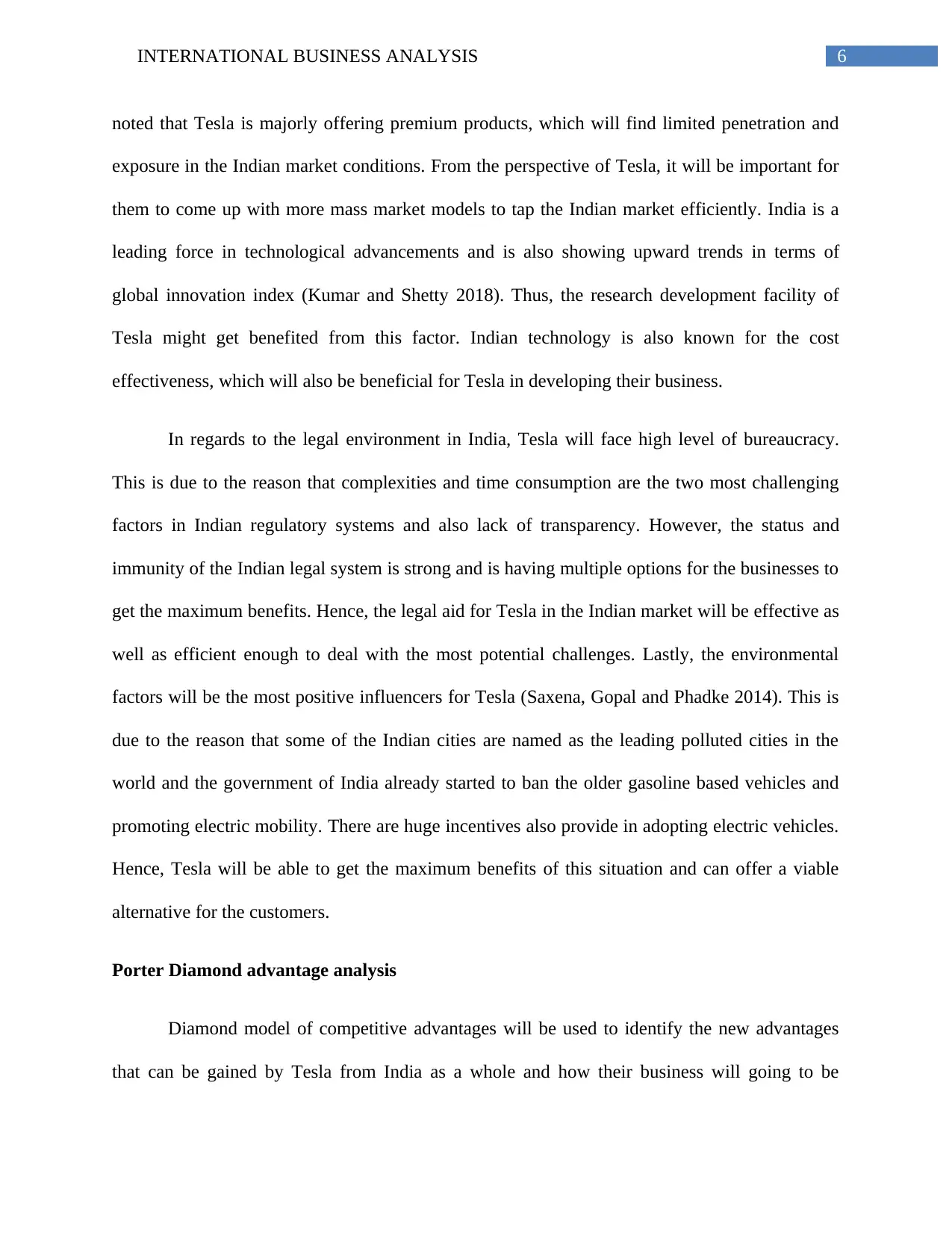
6INTERNATIONAL BUSINESS ANALYSIS
noted that Tesla is majorly offering premium products, which will find limited penetration and
exposure in the Indian market conditions. From the perspective of Tesla, it will be important for
them to come up with more mass market models to tap the Indian market efficiently. India is a
leading force in technological advancements and is also showing upward trends in terms of
global innovation index (Kumar and Shetty 2018). Thus, the research development facility of
Tesla might get benefited from this factor. Indian technology is also known for the cost
effectiveness, which will also be beneficial for Tesla in developing their business.
In regards to the legal environment in India, Tesla will face high level of bureaucracy.
This is due to the reason that complexities and time consumption are the two most challenging
factors in Indian regulatory systems and also lack of transparency. However, the status and
immunity of the Indian legal system is strong and is having multiple options for the businesses to
get the maximum benefits. Hence, the legal aid for Tesla in the Indian market will be effective as
well as efficient enough to deal with the most potential challenges. Lastly, the environmental
factors will be the most positive influencers for Tesla (Saxena, Gopal and Phadke 2014). This is
due to the reason that some of the Indian cities are named as the leading polluted cities in the
world and the government of India already started to ban the older gasoline based vehicles and
promoting electric mobility. There are huge incentives also provide in adopting electric vehicles.
Hence, Tesla will be able to get the maximum benefits of this situation and can offer a viable
alternative for the customers.
Porter Diamond advantage analysis
Diamond model of competitive advantages will be used to identify the new advantages
that can be gained by Tesla from India as a whole and how their business will going to be
noted that Tesla is majorly offering premium products, which will find limited penetration and
exposure in the Indian market conditions. From the perspective of Tesla, it will be important for
them to come up with more mass market models to tap the Indian market efficiently. India is a
leading force in technological advancements and is also showing upward trends in terms of
global innovation index (Kumar and Shetty 2018). Thus, the research development facility of
Tesla might get benefited from this factor. Indian technology is also known for the cost
effectiveness, which will also be beneficial for Tesla in developing their business.
In regards to the legal environment in India, Tesla will face high level of bureaucracy.
This is due to the reason that complexities and time consumption are the two most challenging
factors in Indian regulatory systems and also lack of transparency. However, the status and
immunity of the Indian legal system is strong and is having multiple options for the businesses to
get the maximum benefits. Hence, the legal aid for Tesla in the Indian market will be effective as
well as efficient enough to deal with the most potential challenges. Lastly, the environmental
factors will be the most positive influencers for Tesla (Saxena, Gopal and Phadke 2014). This is
due to the reason that some of the Indian cities are named as the leading polluted cities in the
world and the government of India already started to ban the older gasoline based vehicles and
promoting electric mobility. There are huge incentives also provide in adopting electric vehicles.
Hence, Tesla will be able to get the maximum benefits of this situation and can offer a viable
alternative for the customers.
Porter Diamond advantage analysis
Diamond model of competitive advantages will be used to identify the new advantages
that can be gained by Tesla from India as a whole and how their business will going to be
Paraphrase This Document
Need a fresh take? Get an instant paraphrase of this document with our AI Paraphraser
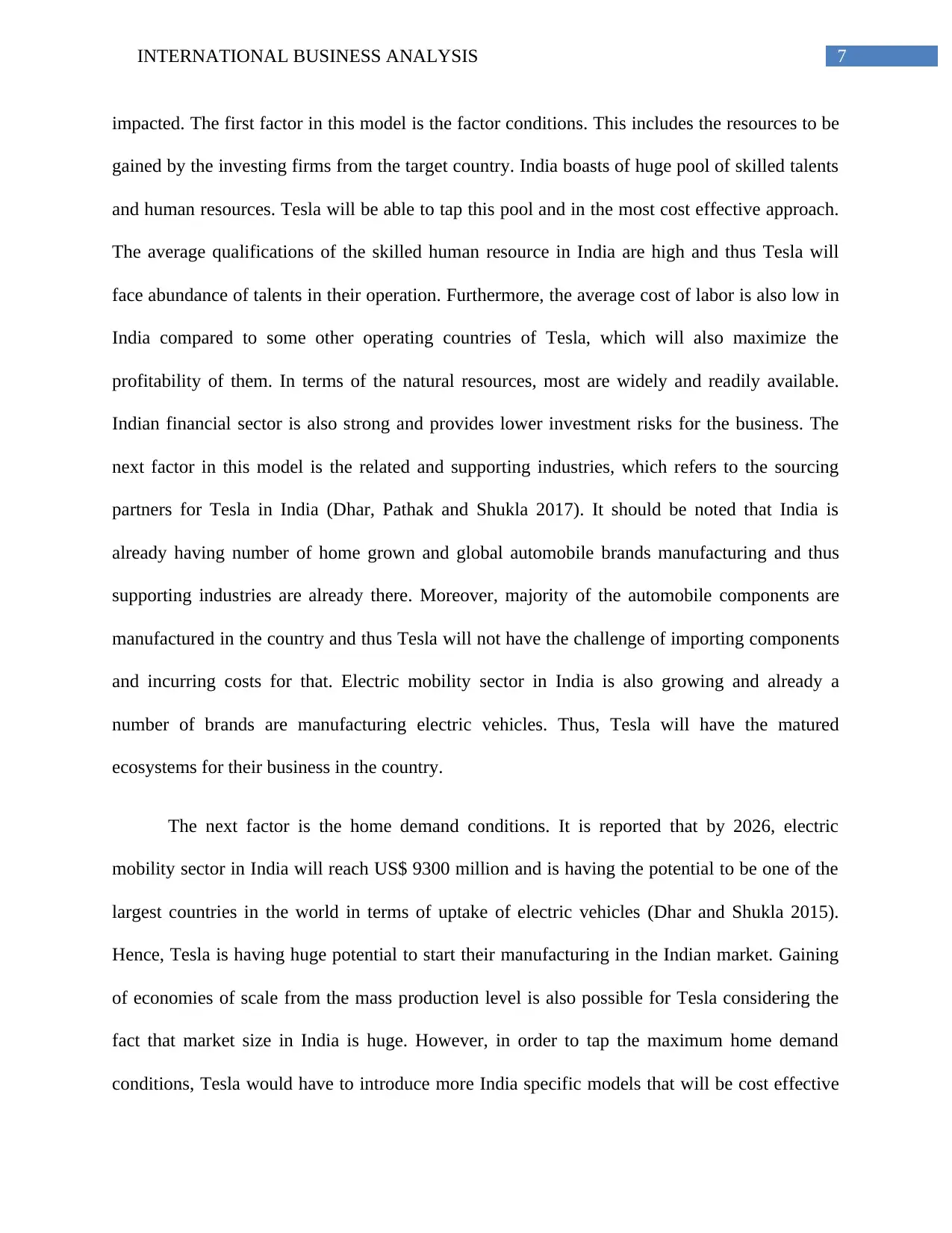
7INTERNATIONAL BUSINESS ANALYSIS
impacted. The first factor in this model is the factor conditions. This includes the resources to be
gained by the investing firms from the target country. India boasts of huge pool of skilled talents
and human resources. Tesla will be able to tap this pool and in the most cost effective approach.
The average qualifications of the skilled human resource in India are high and thus Tesla will
face abundance of talents in their operation. Furthermore, the average cost of labor is also low in
India compared to some other operating countries of Tesla, which will also maximize the
profitability of them. In terms of the natural resources, most are widely and readily available.
Indian financial sector is also strong and provides lower investment risks for the business. The
next factor in this model is the related and supporting industries, which refers to the sourcing
partners for Tesla in India (Dhar, Pathak and Shukla 2017). It should be noted that India is
already having number of home grown and global automobile brands manufacturing and thus
supporting industries are already there. Moreover, majority of the automobile components are
manufactured in the country and thus Tesla will not have the challenge of importing components
and incurring costs for that. Electric mobility sector in India is also growing and already a
number of brands are manufacturing electric vehicles. Thus, Tesla will have the matured
ecosystems for their business in the country.
The next factor is the home demand conditions. It is reported that by 2026, electric
mobility sector in India will reach US$ 9300 million and is having the potential to be one of the
largest countries in the world in terms of uptake of electric vehicles (Dhar and Shukla 2015).
Hence, Tesla is having huge potential to start their manufacturing in the Indian market. Gaining
of economies of scale from the mass production level is also possible for Tesla considering the
fact that market size in India is huge. However, in order to tap the maximum home demand
conditions, Tesla would have to introduce more India specific models that will be cost effective
impacted. The first factor in this model is the factor conditions. This includes the resources to be
gained by the investing firms from the target country. India boasts of huge pool of skilled talents
and human resources. Tesla will be able to tap this pool and in the most cost effective approach.
The average qualifications of the skilled human resource in India are high and thus Tesla will
face abundance of talents in their operation. Furthermore, the average cost of labor is also low in
India compared to some other operating countries of Tesla, which will also maximize the
profitability of them. In terms of the natural resources, most are widely and readily available.
Indian financial sector is also strong and provides lower investment risks for the business. The
next factor in this model is the related and supporting industries, which refers to the sourcing
partners for Tesla in India (Dhar, Pathak and Shukla 2017). It should be noted that India is
already having number of home grown and global automobile brands manufacturing and thus
supporting industries are already there. Moreover, majority of the automobile components are
manufactured in the country and thus Tesla will not have the challenge of importing components
and incurring costs for that. Electric mobility sector in India is also growing and already a
number of brands are manufacturing electric vehicles. Thus, Tesla will have the matured
ecosystems for their business in the country.
The next factor is the home demand conditions. It is reported that by 2026, electric
mobility sector in India will reach US$ 9300 million and is having the potential to be one of the
largest countries in the world in terms of uptake of electric vehicles (Dhar and Shukla 2015).
Hence, Tesla is having huge potential to start their manufacturing in the Indian market. Gaining
of economies of scale from the mass production level is also possible for Tesla considering the
fact that market size in India is huge. However, in order to tap the maximum home demand
conditions, Tesla would have to introduce more India specific models that will be cost effective
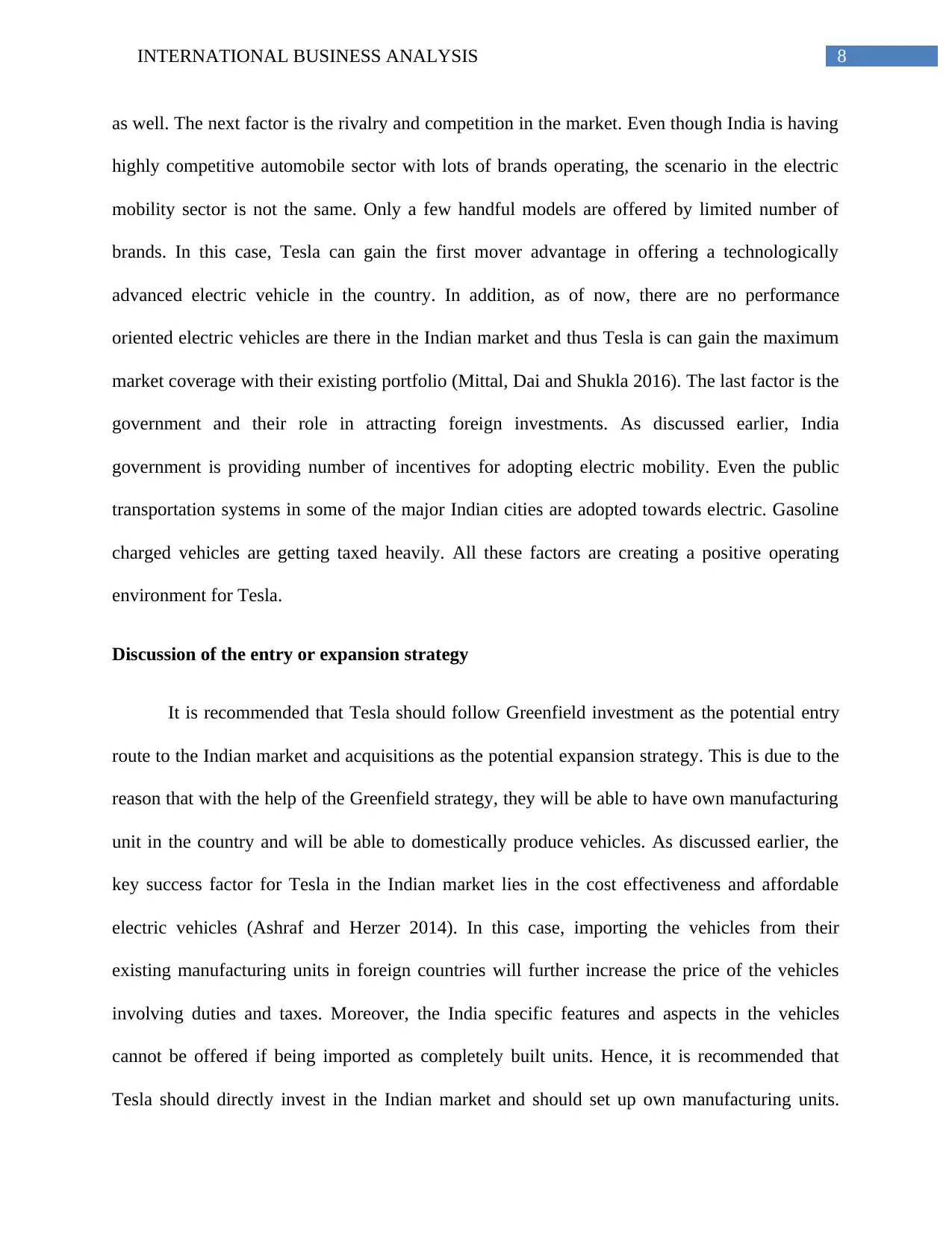
8INTERNATIONAL BUSINESS ANALYSIS
as well. The next factor is the rivalry and competition in the market. Even though India is having
highly competitive automobile sector with lots of brands operating, the scenario in the electric
mobility sector is not the same. Only a few handful models are offered by limited number of
brands. In this case, Tesla can gain the first mover advantage in offering a technologically
advanced electric vehicle in the country. In addition, as of now, there are no performance
oriented electric vehicles are there in the Indian market and thus Tesla is can gain the maximum
market coverage with their existing portfolio (Mittal, Dai and Shukla 2016). The last factor is the
government and their role in attracting foreign investments. As discussed earlier, India
government is providing number of incentives for adopting electric mobility. Even the public
transportation systems in some of the major Indian cities are adopted towards electric. Gasoline
charged vehicles are getting taxed heavily. All these factors are creating a positive operating
environment for Tesla.
Discussion of the entry or expansion strategy
It is recommended that Tesla should follow Greenfield investment as the potential entry
route to the Indian market and acquisitions as the potential expansion strategy. This is due to the
reason that with the help of the Greenfield strategy, they will be able to have own manufacturing
unit in the country and will be able to domestically produce vehicles. As discussed earlier, the
key success factor for Tesla in the Indian market lies in the cost effectiveness and affordable
electric vehicles (Ashraf and Herzer 2014). In this case, importing the vehicles from their
existing manufacturing units in foreign countries will further increase the price of the vehicles
involving duties and taxes. Moreover, the India specific features and aspects in the vehicles
cannot be offered if being imported as completely built units. Hence, it is recommended that
Tesla should directly invest in the Indian market and should set up own manufacturing units.
as well. The next factor is the rivalry and competition in the market. Even though India is having
highly competitive automobile sector with lots of brands operating, the scenario in the electric
mobility sector is not the same. Only a few handful models are offered by limited number of
brands. In this case, Tesla can gain the first mover advantage in offering a technologically
advanced electric vehicle in the country. In addition, as of now, there are no performance
oriented electric vehicles are there in the Indian market and thus Tesla is can gain the maximum
market coverage with their existing portfolio (Mittal, Dai and Shukla 2016). The last factor is the
government and their role in attracting foreign investments. As discussed earlier, India
government is providing number of incentives for adopting electric mobility. Even the public
transportation systems in some of the major Indian cities are adopted towards electric. Gasoline
charged vehicles are getting taxed heavily. All these factors are creating a positive operating
environment for Tesla.
Discussion of the entry or expansion strategy
It is recommended that Tesla should follow Greenfield investment as the potential entry
route to the Indian market and acquisitions as the potential expansion strategy. This is due to the
reason that with the help of the Greenfield strategy, they will be able to have own manufacturing
unit in the country and will be able to domestically produce vehicles. As discussed earlier, the
key success factor for Tesla in the Indian market lies in the cost effectiveness and affordable
electric vehicles (Ashraf and Herzer 2014). In this case, importing the vehicles from their
existing manufacturing units in foreign countries will further increase the price of the vehicles
involving duties and taxes. Moreover, the India specific features and aspects in the vehicles
cannot be offered if being imported as completely built units. Hence, it is recommended that
Tesla should directly invest in the Indian market and should set up own manufacturing units.
⊘ This is a preview!⊘
Do you want full access?
Subscribe today to unlock all pages.

Trusted by 1+ million students worldwide
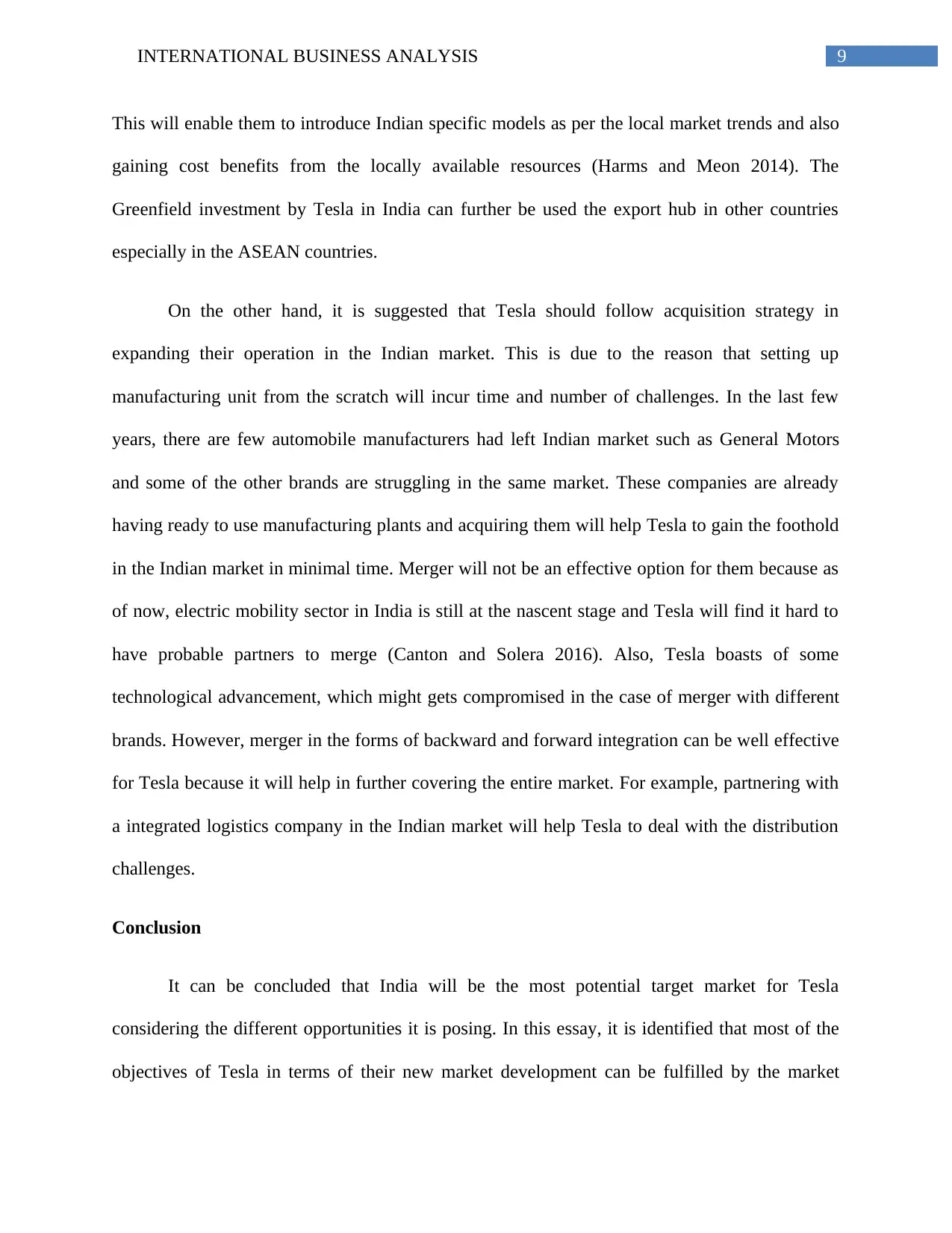
9INTERNATIONAL BUSINESS ANALYSIS
This will enable them to introduce Indian specific models as per the local market trends and also
gaining cost benefits from the locally available resources (Harms and Meon 2014). The
Greenfield investment by Tesla in India can further be used the export hub in other countries
especially in the ASEAN countries.
On the other hand, it is suggested that Tesla should follow acquisition strategy in
expanding their operation in the Indian market. This is due to the reason that setting up
manufacturing unit from the scratch will incur time and number of challenges. In the last few
years, there are few automobile manufacturers had left Indian market such as General Motors
and some of the other brands are struggling in the same market. These companies are already
having ready to use manufacturing plants and acquiring them will help Tesla to gain the foothold
in the Indian market in minimal time. Merger will not be an effective option for them because as
of now, electric mobility sector in India is still at the nascent stage and Tesla will find it hard to
have probable partners to merge (Canton and Solera 2016). Also, Tesla boasts of some
technological advancement, which might gets compromised in the case of merger with different
brands. However, merger in the forms of backward and forward integration can be well effective
for Tesla because it will help in further covering the entire market. For example, partnering with
a integrated logistics company in the Indian market will help Tesla to deal with the distribution
challenges.
Conclusion
It can be concluded that India will be the most potential target market for Tesla
considering the different opportunities it is posing. In this essay, it is identified that most of the
objectives of Tesla in terms of their new market development can be fulfilled by the market
This will enable them to introduce Indian specific models as per the local market trends and also
gaining cost benefits from the locally available resources (Harms and Meon 2014). The
Greenfield investment by Tesla in India can further be used the export hub in other countries
especially in the ASEAN countries.
On the other hand, it is suggested that Tesla should follow acquisition strategy in
expanding their operation in the Indian market. This is due to the reason that setting up
manufacturing unit from the scratch will incur time and number of challenges. In the last few
years, there are few automobile manufacturers had left Indian market such as General Motors
and some of the other brands are struggling in the same market. These companies are already
having ready to use manufacturing plants and acquiring them will help Tesla to gain the foothold
in the Indian market in minimal time. Merger will not be an effective option for them because as
of now, electric mobility sector in India is still at the nascent stage and Tesla will find it hard to
have probable partners to merge (Canton and Solera 2016). Also, Tesla boasts of some
technological advancement, which might gets compromised in the case of merger with different
brands. However, merger in the forms of backward and forward integration can be well effective
for Tesla because it will help in further covering the entire market. For example, partnering with
a integrated logistics company in the Indian market will help Tesla to deal with the distribution
challenges.
Conclusion
It can be concluded that India will be the most potential target market for Tesla
considering the different opportunities it is posing. In this essay, it is identified that most of the
objectives of Tesla in terms of their new market development can be fulfilled by the market
Paraphrase This Document
Need a fresh take? Get an instant paraphrase of this document with our AI Paraphraser
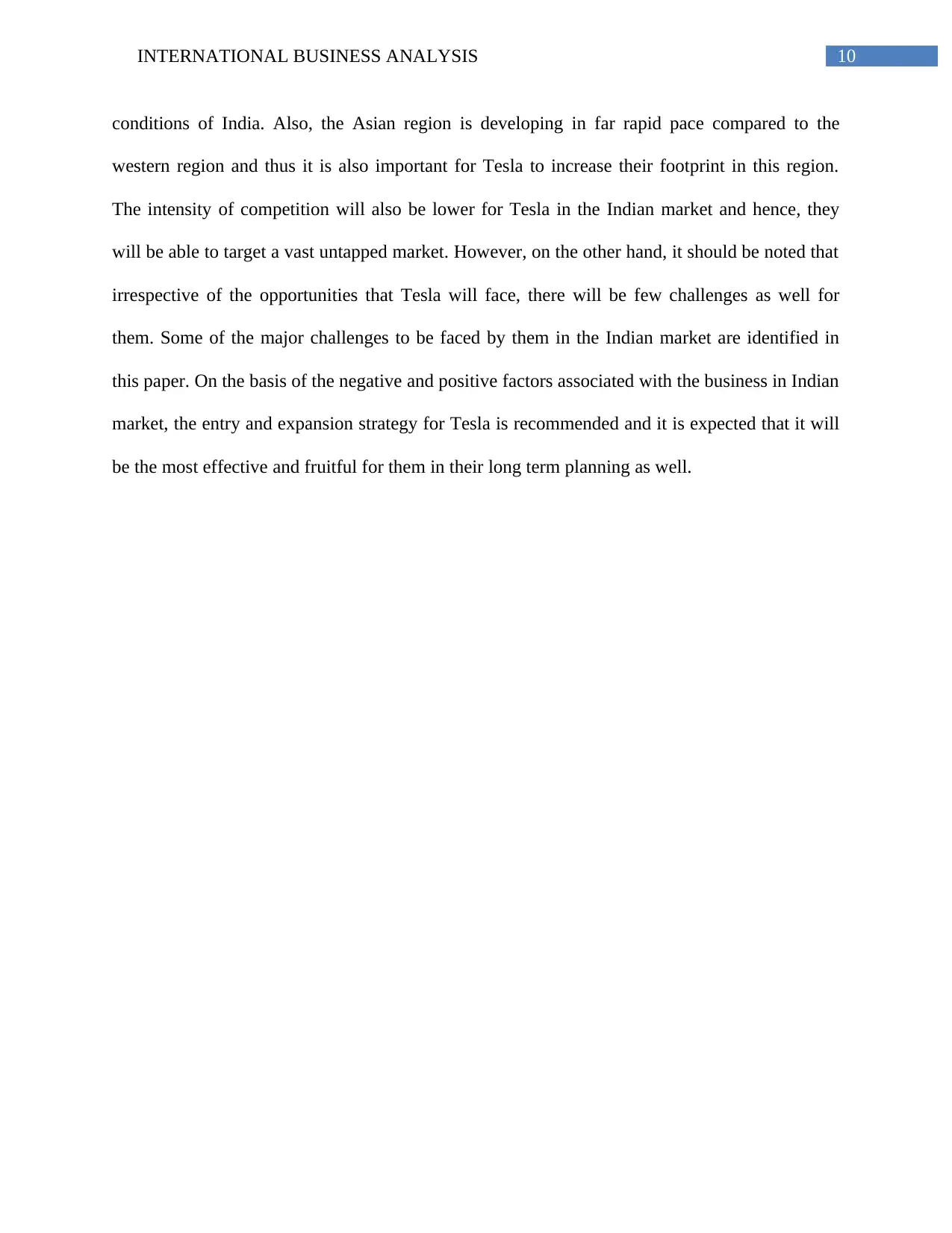
10INTERNATIONAL BUSINESS ANALYSIS
conditions of India. Also, the Asian region is developing in far rapid pace compared to the
western region and thus it is also important for Tesla to increase their footprint in this region.
The intensity of competition will also be lower for Tesla in the Indian market and hence, they
will be able to target a vast untapped market. However, on the other hand, it should be noted that
irrespective of the opportunities that Tesla will face, there will be few challenges as well for
them. Some of the major challenges to be faced by them in the Indian market are identified in
this paper. On the basis of the negative and positive factors associated with the business in Indian
market, the entry and expansion strategy for Tesla is recommended and it is expected that it will
be the most effective and fruitful for them in their long term planning as well.
conditions of India. Also, the Asian region is developing in far rapid pace compared to the
western region and thus it is also important for Tesla to increase their footprint in this region.
The intensity of competition will also be lower for Tesla in the Indian market and hence, they
will be able to target a vast untapped market. However, on the other hand, it should be noted that
irrespective of the opportunities that Tesla will face, there will be few challenges as well for
them. Some of the major challenges to be faced by them in the Indian market are identified in
this paper. On the basis of the negative and positive factors associated with the business in Indian
market, the entry and expansion strategy for Tesla is recommended and it is expected that it will
be the most effective and fruitful for them in their long term planning as well.
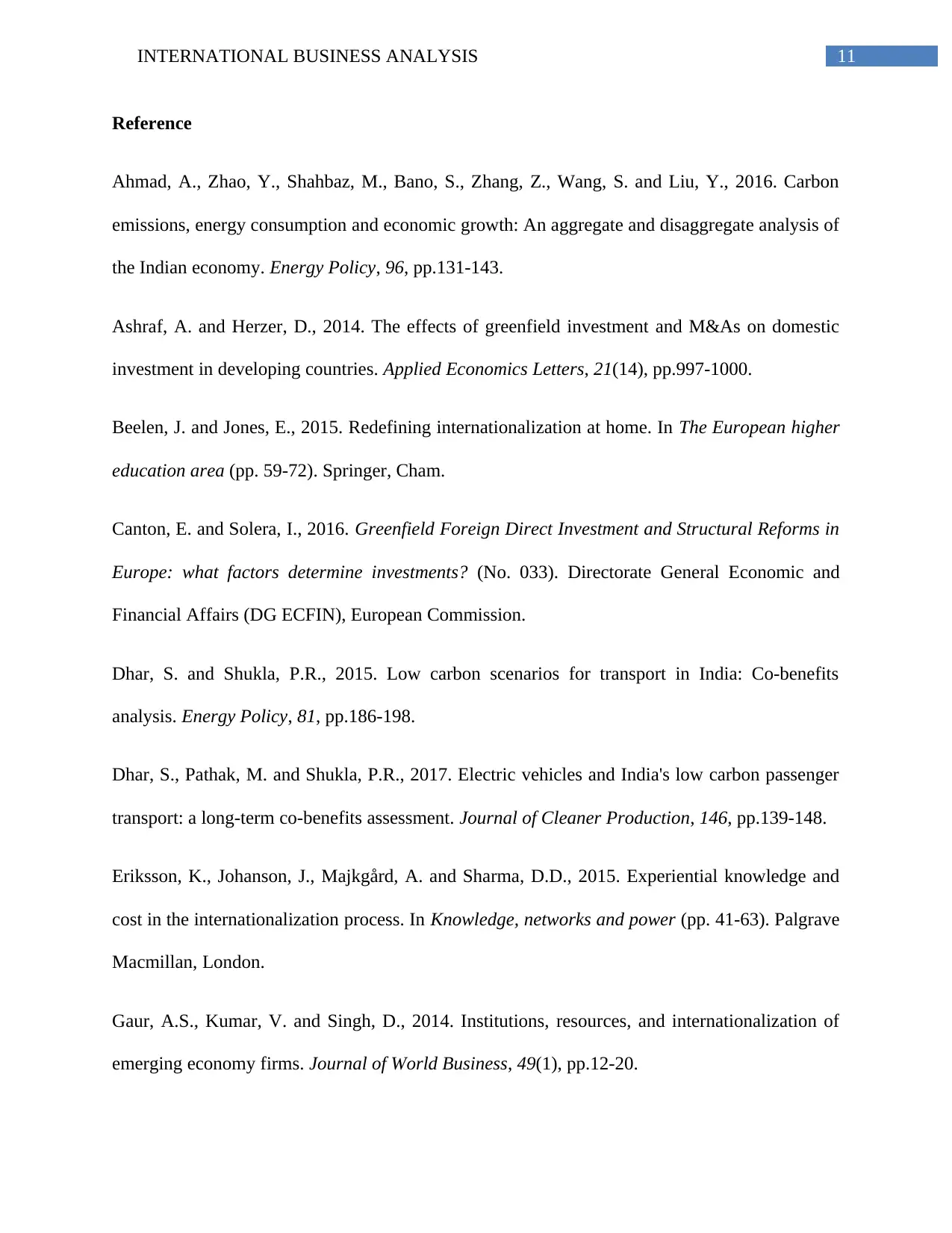
11INTERNATIONAL BUSINESS ANALYSIS
Reference
Ahmad, A., Zhao, Y., Shahbaz, M., Bano, S., Zhang, Z., Wang, S. and Liu, Y., 2016. Carbon
emissions, energy consumption and economic growth: An aggregate and disaggregate analysis of
the Indian economy. Energy Policy, 96, pp.131-143.
Ashraf, A. and Herzer, D., 2014. The effects of greenfield investment and M&As on domestic
investment in developing countries. Applied Economics Letters, 21(14), pp.997-1000.
Beelen, J. and Jones, E., 2015. Redefining internationalization at home. In The European higher
education area (pp. 59-72). Springer, Cham.
Canton, E. and Solera, I., 2016. Greenfield Foreign Direct Investment and Structural Reforms in
Europe: what factors determine investments? (No. 033). Directorate General Economic and
Financial Affairs (DG ECFIN), European Commission.
Dhar, S. and Shukla, P.R., 2015. Low carbon scenarios for transport in India: Co-benefits
analysis. Energy Policy, 81, pp.186-198.
Dhar, S., Pathak, M. and Shukla, P.R., 2017. Electric vehicles and India's low carbon passenger
transport: a long-term co-benefits assessment. Journal of Cleaner Production, 146, pp.139-148.
Eriksson, K., Johanson, J., Majkgård, A. and Sharma, D.D., 2015. Experiential knowledge and
cost in the internationalization process. In Knowledge, networks and power (pp. 41-63). Palgrave
Macmillan, London.
Gaur, A.S., Kumar, V. and Singh, D., 2014. Institutions, resources, and internationalization of
emerging economy firms. Journal of World Business, 49(1), pp.12-20.
Reference
Ahmad, A., Zhao, Y., Shahbaz, M., Bano, S., Zhang, Z., Wang, S. and Liu, Y., 2016. Carbon
emissions, energy consumption and economic growth: An aggregate and disaggregate analysis of
the Indian economy. Energy Policy, 96, pp.131-143.
Ashraf, A. and Herzer, D., 2014. The effects of greenfield investment and M&As on domestic
investment in developing countries. Applied Economics Letters, 21(14), pp.997-1000.
Beelen, J. and Jones, E., 2015. Redefining internationalization at home. In The European higher
education area (pp. 59-72). Springer, Cham.
Canton, E. and Solera, I., 2016. Greenfield Foreign Direct Investment and Structural Reforms in
Europe: what factors determine investments? (No. 033). Directorate General Economic and
Financial Affairs (DG ECFIN), European Commission.
Dhar, S. and Shukla, P.R., 2015. Low carbon scenarios for transport in India: Co-benefits
analysis. Energy Policy, 81, pp.186-198.
Dhar, S., Pathak, M. and Shukla, P.R., 2017. Electric vehicles and India's low carbon passenger
transport: a long-term co-benefits assessment. Journal of Cleaner Production, 146, pp.139-148.
Eriksson, K., Johanson, J., Majkgård, A. and Sharma, D.D., 2015. Experiential knowledge and
cost in the internationalization process. In Knowledge, networks and power (pp. 41-63). Palgrave
Macmillan, London.
Gaur, A.S., Kumar, V. and Singh, D., 2014. Institutions, resources, and internationalization of
emerging economy firms. Journal of World Business, 49(1), pp.12-20.
⊘ This is a preview!⊘
Do you want full access?
Subscribe today to unlock all pages.

Trusted by 1+ million students worldwide
1 out of 17
Related Documents
Your All-in-One AI-Powered Toolkit for Academic Success.
+13062052269
info@desklib.com
Available 24*7 on WhatsApp / Email
![[object Object]](/_next/static/media/star-bottom.7253800d.svg)
Unlock your academic potential
Copyright © 2020–2025 A2Z Services. All Rights Reserved. Developed and managed by ZUCOL.





